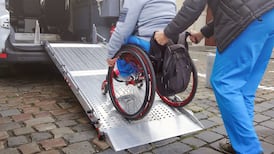Personal space is a changeable thing. On a crowded bus, a classic case of manspreading, where a man typically takes up more room than necessary, is a sharp intrusion of personal space, whereas with a love interest, the brush of a hand against yours is a highly sought-after shock of electricity.
Lately, personal space has been redefined but it is space that disabled people never had in the first place.
On the bus, the seats behind, in front of and beside us are empty, giving us a treasured break from manspreaders and love interests? Well, congratulations to anyone who managed to make that work during the Covid-19 lockdown. In theory, we should be moving around with an invisible two-metre stick, keeping our distance from people out on the streets and in the supermarket aisles, but a stroll through any town shows that this invisible stick – this new measurement of personal space – is also a changeable thing.
As a wheelchair user and former crutches walker, I am always aware of the space around me or the space that I’ve been told that I take up. The presence of my chair, and previously my crutches, is cited as a safety concern for others or a fire hazard, depending on the location. When booking flights or finding holiday accommodation with suitable door frames and hallways, I have to send my dimensions, a tidy 36x24 inches.
In bars and restaurants, my wheelchair is knocked against by customers and serving staff, no matter how tightly I’m tucked away into a corner, and the hullabaloo it takes to clear a pathway from the front to the back of these venues proves that they were never laid out for wheelchair users to move around in.
Social distancing
Pathways have always been a tight squeeze, thanks to sandwich boards, badly locked bikes, bins, lampposts and unbudgeable groups of friends smoking, catching up or saying their goodbyes, but now they’ve become even tighter. As we try to accommodate our new social distancing regulations with outdoor dining and seating areas, newly pedestrianised streets and queuing systems that snake around corners, the space that wheelchair users and people with mobility issues need has been further reduced.
Most footpaths are fitted between a wall and a kerb, a kerb that usually drops down to a road. When it comes to maintaining any distance out in the wild, the choice entirely lies in the hands of those around me. Unable to absorb into walls – any day now, the science will catch up with our desires – and unable to step down on to the road, I have to hope that the people around me observe not just the space that they’re taking up but the space that I cannot. More often than not, this space and the invisible two-metre stick is ignored so I wear my face mask everywhere to protect myself and others. I can’t step aside so I cover up instead.
For the first two months of lockdown, the roads were quiet. Smooth and spacious, they felt safer to use but as life returns from standstill mode, so does the traffic. Even if loading bays are temporarily cordoned off as walking space, wheelchair users still cannot step down and make use of them. These temporary measures will only work if people properly observe who is around them. I mean this generally and specifically.
Thronged streets
As pubs and restaurants maintain social distancing behind doors, finally having clear pathways from the back to the front, the majority of their customers spill out into the streets with nowhere to bring their takeaway meals and pints in plastic cups. Groups of 15 merge into other groups of 15, turning the streets into extended bars and making the pathways non-existent. The end of the night sees the pathways decorated with discarded cups and disposed face masks, consideration for everyone else all but gone.
In the coming weeks, more pubs and restaurants will reopen with new layouts in action but nightclubs and music venues will remain closed, sitting empty for an unknown period of time. Using this summer fallow to reimagine how they will operate when the live music industry picks back up again, I hope the owners properly and permanently include the needs of disabled people, and the room that we require, in their plans.
In the fright and the pause of a pandemic, we’ve been given the chance to re-examine and refresh the way in which we use the space around us. Personal space is a changeable thing but not all of us have the ability or the privilege to maintain it. Disabled people are aware of the space we inhabit, I just wish that non-disabled people would learn to do the same.
We are moving through the world at a different pace but if things ever return to the way they were before, remember to save space for disabled people too.










